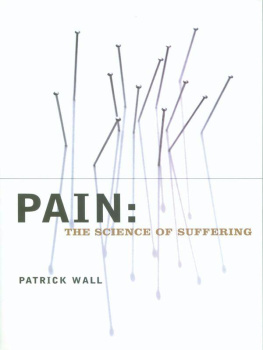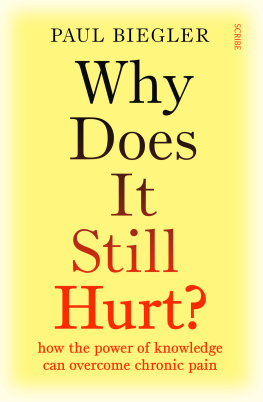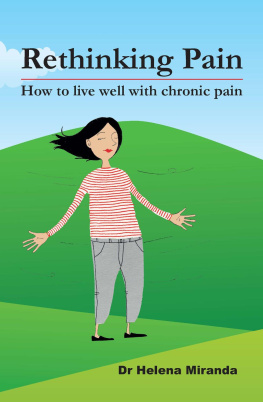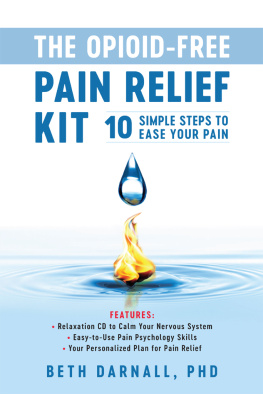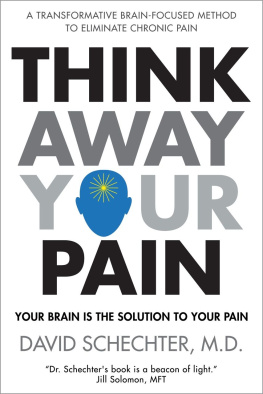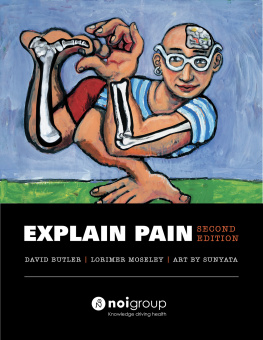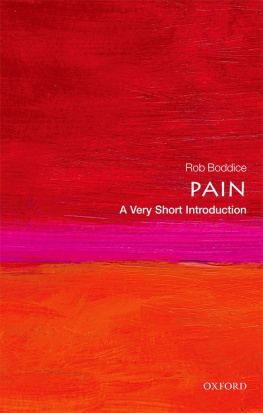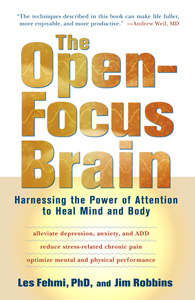Pain
MAPS OF THE MIND
S TEVEN R OSE , G ENERAL E DITOR
MAPS OF THE MIND
S TEVEN R OSE , G ENERAL E DITOR
The Making of Intelligence
Ken Richardson
How Brains Make Up Their Minds
Walter J. Freeman
Sexing the Brain
Lesley Rogers
Intoxicating Minds: How Drugs Work
Ciaran Regan
How to Build a Mind: Toward Machines with Imagination
Igor Aleksander
The Aging Brain
Lawrence Whalley
The Unbalanced Mind
Julian Leff
Columbia University Press
Publishers Since 1893
New York Chichester, West Sussex
cup.columbia.edu
Copyright 2000 Patrick Wall
First published by Weidenfeld and Nicolson Ltd., London
All rights reserved
E-ISBN 978-0-231-52940-2
Library of Congress Cataloging-in-Publication Data
Wall, Patrick D. (Patrick David), 1925
Pain : the science of suffering / Patrick Wall.
p. cm.(Maps of the mind)
Includes index.
ISBN 0231120060 (cloth)ISBN 0231120079 (paper)
1. Pain. I. Title. II. Series.
RB127.W355 2000
616.0472dc21
00023889
A Columbia University Press E-book.
CUP would be pleased to hear about your reading experience with this e-book at .
Contents

This book will explore all we know now about the nature and causes of pain. There is good reason to do this because we have all experienced pain and are puzzled by it. We all fear for the future. Furthermore, we have all witnessed others in pain and have wondered in sympathy at their experience and our often frustrated attempts to help them. We will begin with the surprising facts about what people and animals do and experience when their bodies are damaged. We need to start with this because we have to clear our minds of the idea of a rigid, simple signaling system. It is simply not true that a particular injury generates a fixed amount of pain, and that feeling pain means injury. We shall then divert briefly to the confused mess generated by philosophers who constructed idealized rational sensory systems in happy ignorance of the working of living organisms. We will rapidly return to the real world of our nervous systems and how we and others react to our injuries, pain, and suffering. The rationale of successful therapies will be reviewed, as will the nature of intractable pains, which still defeat everyone. Finally, we shall try to fit these facts into a scheme by which the body and brain bring together all the relevant data to make an overall posture that generates our sense of ease or distress.
My desire to write this book comes from my own history. More than fifty years ago, as a medical student, I began to see patients in pain and realized that the explanations given to them and to me by my teachers were overt rubbish. The fantasy explanations often depended
on mechanical disorders for which there was no evidence, such as trapped nerves, extra ribs, strained muscles, or floating kidneys. If those failed to convince even the doctors, there was a leap to using as an explanation the supposed inadequate personalities of the patients: neurosis, hypochondria, hysteria, and malingering.
Over forty years ago, I began, as a neuroscientist, to examine the conducting nervous system of animals. It was immediately apparent that the predicted hard-wired, line-dedicated, specialized pain system did not exist. Rather, there is a subtle multiplexed reactive system that informs us simultaneously about events in the tissues and in the thinking parts of the brain. As a consequence of these studies, it became apparent that the separation of sensation from perception was quite artificial and that sensory and cognitive mechanisms operated as a whole. Since that time, a large number of highly inventive scientists, psychologists, and clinicians have joined to create a contemporary picture of pain mechanisms. Last, like anyone, I have a personal concern with my own pain, in my case dominated by a widespread cancer (which is for the time being responding to therapy).
This is not a textbook. There are many such books, including The Challenge of Pain (Penguin, London, 1999), written by myself and Ron Melzack, and the fourth edition of the Textbook of Pain (Churchill-Livingstone, Edinburgh, 1999), which Melzack and I edited. Neither is this book a do-it-yourself recipe book for pain relief. It is intended to give the readers the power of understanding processes in their own body.
I am indebted to the advice of friends: Peter and Nehama Hillman, Sue Draney, Julia and Robert Kibblewhite, Steven Rose, the series editor, Peter Tallack, the editor, and, of course, Mary Helton.
This book reflects the awakening of study and concern about pain that has been growing for twenty years. I am in awe of the group of younger scientists who have taken up the challenge. I hugely admire the new breed of clinicians who are leading treatment out of the barren desert of ignorance and neglect. Above all, this book is inspired by those who suffer and those who care. They are our ultimate teachers. This book is created both by and for them.

It is crucial that we begin with precise and objective reports of what people and animals do when injured. The reports do not match the expectation of the victim or of the observer. In exploring the nature of pain, it will be necessary to separate reality from what we think ought to be observed. We will start with sudden events where a previously normal being is abruptly converted to a sick one. Of course, no such event occurs in a vacuum, as there is always a surrounding scene and the victim arrives at the accident with a personal and genetic history. Later, we will have to incorporate the vastly more common and less dramatic situation in which the onset of disease and pain is insidious.
A Swiss Army Officer
A forty-three-year-old reserve major, described by his wife as tough and taciturn, was skiing with his squad in the Upper Engadine region of Switzerland when a snow bridge collapsed below him. He remembers free falling into a crevasse with ice walls in front and behind, and scraping down one wall. With a tremendous crash and thump, he found himself wedged firmly in the ice crack. One arm was jammed above his head and he could not move his legs. He remembers hearing his gun and ski poles rattling down below, deeper into the crevasse. He was winded but was surprised to feel no pain whatsoever. He looked up and saw his men peering over the brink, and called out that he was all right but could not move.
A man was lowered down to him on a line and put a sling around him. The men above hauled on the ropes, and he remembers his relief on feeling himself swaying free. They carried him down to an open area and radioed for a helicopter, which arrived after twenty-five minutes. His men were unusually quiet and subdued, in contrast to their normal boisterous behavior. He recalls feeling ashamed, as he had lectured on how to avoid such accidents. He wondered what this would do to his chances of promotion, and discussed this with the sergeant, who tried to cheer him up. During all this time, he recalls no trace of pain, either when he hit the ice slot or during his rescue.

